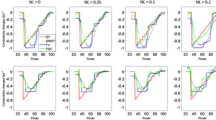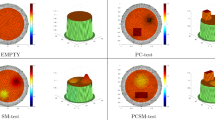Abstract
Electrical impedance tomography (EIT) reconstructs internal impedance images of the body from electrical measurements on body surface. The temporal resolution of EIT data can be very high, although the spatial resolution of the images is relatively low. Most EIT reconstruction algorithms calculate images from data frames independently, although data are actually highly correlated especially in high speed EIT systems. This paper proposes a 4-D EIT image reconstruction for functional EIT. The new approach is developed to directly use prior models of the temporal correlations among images and 3-D spatial correlations among image elements. A fast algorithm is also developed to reconstruct the regularized images. Image reconstruction is posed in terms of an augmented image and measurement vector which are concatenated from a specific number of previous and future frames. The reconstruction is then based on an augmented regularization matrix which reflects the a priori constraints on temporal and 3-D spatial correlations of image elements. A temporal factor reflecting the relative strength of the image correlation is objectively calculated from measurement data. Results show that image reconstruction models which account for inter-element correlations, in both space and time, show improved resolution and noise performance, in comparison to simpler image models.





Similar content being viewed by others
References
Adler A, Guardo R (1996) Electrical impedance tomography: regularised imaging and contrast detection. IEEE Trans Medi Imaging 15:170–179
Adler A, Guardo R, Berthiaume Y (1996) Impedance imaging of lung ventilation: do we need to account for chest expansion?. IEEE Trans Biomed Eng 43(4):414–420
Adler A, Lionheart WRB (2006) Uses and abuses of EIDORS: an extensible software base for EIT. Physiol Meas 27:25–42
Adler A, Dai T, Lionheart WRB (2007) Temporal image reconstruction in electrical impedance tomography. Physiol Meas 28:1–11
Babaeizadeh S, Brooks DH (2006) Effects of electrode location error on boundary element impedance tomography solutions: CR bounds and simulation results. In: 3rd IEEE ISBI: nano to macro, pp. 1080–1083
Babaeizadeh S, Brooks DH (2007) Electrical impedance tomography for piecewise constant domains using boundary element shape-based inverse solutions. IEEE Trans on Med Imaging 26(5):637–647
Bacrie CC, Goussard Y, Guardo R (1997) Regularized reconstruction in electrical impedance tomography using a variance uniformization constraint. IEEE Trans Med Imag 16(5):562–571
Bollmann A, Kanuru NK, McTeague KK, Walter PF, DeLurgio DB, Langberg JJ (1998) Frequency analysis of human atrial fibrillation using the surface electrocardiogram and its response to ibutilide. Am J Cardiol 81(12):1439–1445
Boone KG, Holder DS (1996) Effect of skin impedance on image quality and variability in electrical impedance tomography: a model study. Med Biol Eng Comput 34(5):351–354
Cheney M, Isaacson D, Newell JC, Simske S, Goble JC (1990) NOSER: an algorithm for solving the inverse conductivity problem. Int J Imaging Syst Technol 2:66–75
Colton D, Kress R (1992) Inverse acoustic and electromagnetic scattering theory. Springer, Berlin, pp. 121, 289 (new edition: 1998, p. 133, 304)
Dai T, Soleimani M, Adler A (2007) Four-dimensional regularization for electrical impedance tomography imaging. In: VIII Conference on electrical impedance tomography, Graz, 29 August–2 September 2007
Dehgani H, Soni N, Halter R, Hartov A, Paulsen KD (2005) Excitation patterns in three-dimensional electrical impedance tomography. Physiol Meas 26:185–197
Eyuboglu BM, Brown BH, Barber DC (1989) In vivo imaging of cardiac related impedance changes. IEEE Eng Med Biol Mag 8(1):39–45
Frerichs I (2000) Electrical impedance tomography (EIT) in applications related to lung and ventilation: a review of experimental and clinical activities. Physiol Meas 21:1–21
Van Genderingen HR, van Vught AJ, Jansen JRC (2004) Regional lung volume during high-frequency oscillatory ventilation by electrical impedance tomography. Crit Care Med 32:787–794
Graham B, Adler A (2007) Electrode placement configurations for 3D EIT. Physiol Meas 28:29–44
Hammermeister KE, Brooks RC, Warbasse JR (1974) The rate of change of left ventricular volume in Man: I. Validation and peak systolic ejection rate in health and disease. Circulation 49:729–738
Harris ND, Brown BH, Barber DC (1992) Continuous monitoring of lung ventilation with electrical impedance tomography. Med Biol Soc :1754–1755
Holder DS (1992) Electrical impedance tomography of brain function. Brain Topogr 5:87–93
Kohler BU, Henning C, Orglmeister R (2002) The principles of software QRS detection. IEEE Eng Med Biol Mag 21:42–57
Lionheart W, Polydorides N, Borsic A (2005) Why is EIT so hard. In: Holder DS (Ed) Electrical impedance tomography: methods, history and applications. IOP, Bristol
Metherall P, Barber DC, Smallwood RH, Brown BH (1996) Three dimensional electrical impedance tomography. Nature 380:509–512
Ormiston JA, Shah PM, Tei C, Wong M (1981) Size and motion of the mitral valve annulus in man. I. A two-dimensional echocardiographic method and findings in normal subjects. Circulation 64: 113–120
Schmitt U, Louis AK (2002) Efficient algorithms for the regularization of dynamic inverse problems: I. Theory. Inverse Probl 18(3):645–658
Schmitt U, Louis AK, Wolters C, Vauhkonen M (2002) Efficient algorithms for the regularization of dynamic inverse problems: II. Applications. Inverse Probl 18(3):659–676
Seppanen A, Vauhkonen M, Vauhkonen PJ, Somersalo E, Kaipio JP (2001) State estimation with fluid dynamical models in process tomography—an application with impedance tomography. Inverse Probl 17:467–483
Soleimani M, Adler A, Dai T, Peyton AJ (2008) Application of a single step temporal imaging of magnetic induction tomography for metal flow visualization. Insight 50(1):25–29
Tidswell AT, Gibson A, Bayford RH, Holder DS (2001)Electrical impedance tomography of human brain activity with a two-dimensional ring of scalp electrodes. Physiol Meas 22:167–175
Tossavainen OP, Vauhkonen M, Heikkinen LM, Savolainen T (2004) Estimating shapes and freesurfaces with electrical impedance tomography. Meas Sci Technol 15:1402–1411
Vauhkonen PJ, Vauhkonen M, Savolainen T, Kaipio JP (1999) Three-dimensional electrical impedance tomography based on the complete electrode model. IEEE Trans Biomed Eng 46(9):1150–1160
Vauhkonen M, Karjalainen PA, Kaipio JP (1998) A Kalman filter approach to track fast impedance changes in electrical impedance tomography. IEEE Trans Biomed Eng 45:486–493
Vonk-Noordegraaf A, Janse A, Marcus JT, Bronzwaer JG, Postmus PE, Faes TJC, de Vries PM (2000) Determination of stroke volume by means of electrical impedance tomography. Physiol Meas 21:285–293
Wilkinson AJ, Randall EW, Cilliers JJ, Durrett DR, Naidoo T, Long T (2005) A 1000-measurement frames/second ERT data capture system with real-time visualization. IEEE Sens J 5:300–307
Wolf GK, Arnold JH (2005) Noninvasive assessment of lung volume: respiratory inductance plethysmography and electrical impedance tomography. Crit Care Med 33:163–169
Yorkey TJ, Webster JG, Tompkins WJ (1987) Comparing reconstruction algorithms for electrical impedance tomography. IEEE Trans Biomed Eng 34:843–852
Acknowledgments
This work was supported by a grant from NSERC Canada.
Author information
Authors and Affiliations
Corresponding author
Rights and permissions
About this article
Cite this article
Dai, T., Soleimani, M. & Adler, A. EIT image reconstruction with four dimensional regularization. Med Biol Eng Comput 46, 889–899 (2008). https://doi.org/10.1007/s11517-008-0371-6
Received:
Accepted:
Published:
Issue Date:
DOI: https://doi.org/10.1007/s11517-008-0371-6




